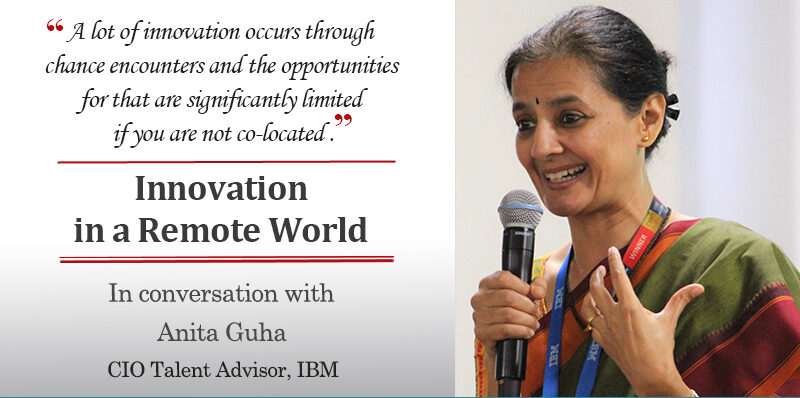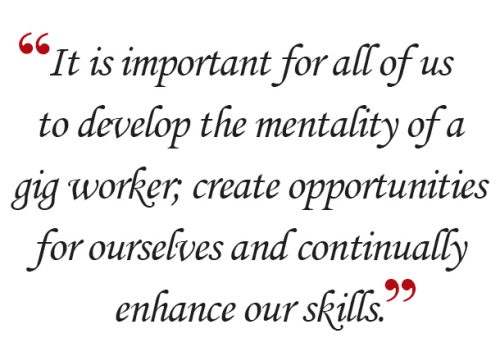TAQ in dialogue with Anita Guha, CIO Talent Advisor, IBM
As organisations continue to manage fresh and evolving challenges thrown up by the Covid-19 crisis, the focus is shifting towards maintaining a uniform work culture, a healthy balance between the personal and professional, and reskilling for a post-pandemic gig economy. As part of our study of the evolving workplace Sangeetha Rajan, Co-Founder TAQ, spoke with Anita Guha, CIO Talent Advisor, IBM. In this conversation, she shares her experience during the lockdown, its impact on productivity, and the role of resilience and agility for a better tomorrow. Here are some excerpts from the interview.
Co-location and COVID-19
Our CIO organisation’s mission is to make IBMers more productive. Our teams do this by managing all the IT applications and infrastructure which IBMers use to get their work done. The philosophy of our teams has been to be agile and co-located.
Agile means that you focus on the client, keep adjusting to what the client needs, iterate until you co-create a solution. This is in contrast to spending loads of time to develop a product only to discover that the client has changed his mind or needs something different. An agile approach helps us be responsive; we keep sharing parts of a work product, getting feedback, changing and delivering.
Co-location means working together physically. Distributed work offers flexibility, but innovation often occurs through chance encounters. If you’re working from home, then the opportunities for these are fewer and innovation also diminishes. When we are together, we are sharing experiences, listening to one another, sharing expertise. There is a constant cross-fertilization of ideas. Co-location meant not just being on the same campus or same building, but in the same space – we use the term congestion – as in, we are all in the same space so that we are cheek-by-jowl with one another. If we’re all in the same space, we can also invest in that space. In fact, in March this year, we were on the eve of launching an awesome open office at our Manyata location in Bangalore, where the bulk of our employees used to sit We had a competition to select winning photographs that were to be blown up as part of the new office décor. The space was to be personalized for the people occupying it.
And suddenly, COVID-19 hit us. We were like, “Oh my God, what happened?”
Everyone’s started working from home. And, surprise surprise, we were super productive, at least for a while! But as the 6th month looms ahead, fatigue is beginning to set in. Our leaders have started implementing different initiatives to retain the connection with people.
Boundaries between work and life
Work-life balance has always been a challenge, but it has become exacerbated because the work-from-home model has been forced on everyone. People’s personal space is getting sort of invaded! Everybody on my webex can look into my living room, for example. People struggle with their home/personal lives encroaching on their work, but it’s really the other way around: work is now encroaching on our home space.
IBM has been quite upfront and sensitive about such matters. We have invited employees to sign an IBM pledge which includes respect for personal space. While we encourage people to put their videos on to create a personal touch, there’s no stigma if you choose not to put on your video. You can blur your background if you don’t want people to see the space you are in. We have also suggested leaders schedule a kind of buffer zone between meetings – instead of one hour meeting, do 50 minutes. If it is half hour, do 20 or 25 minutes. Don’t schedule meetings that end at the hour because then the next meeting starts. If you’re sitting in one place in back to back meetings, then you’ll naturally get pretty exhausted by the end of the day, right? We also need our leaders to demonstrate personal interest; to consider the individual as a person rather than a mere utility. Even if the work is urgent, take a moment to check in with that person and what is happening instead of getting straight to the task at hand, for example. And as leaders role model it, others follow. Why is so much of the onus on leaders? Well, there is a power equation in all this. Leaders can set boundaries, but it is harder for a junior person to negotiate. COVID-19 has brought many job losses in its wake and that has further reduced employee negotiating power. So, our leaders must set the right tone: communicating with a personal touch is important.
The future of innovation
Co-location now seems like a distant dream. It is not really a reasonable thing to explore until the end of 2021. Of course, one and a half years in the history of a 100+ year old company is not going to change everything. But it might lead to a complete rethink in the way we work. It’s not clear when, if ever, we will return to the congested model of the past.
Co-location and congestion created the positive outcome of innovation.
So, our challenge is going to be how to find ways to achieve that innovation, despite the fact that the physical togetherness is absent.
That is a big question for the immediate future. We know that informal conversations are the spaces where innovation thrives. So how do we create those informal spaces? One way is through more fun at work activities. For example, we run a monthly virtual chai adda where people are randomly grouped to meet for chai! They take 30-40 minutes out of their schedule to talk to each other about who they are, what they are working on – over webex! And there’s a group photo at the end! There are many virtual collaborative tools that we are trying to use more effectively; as GitHub, Mural, Slack become more ubiquitous, they can empower our innovation muscles!
Leading in the future
The requirement for leaders in a VUCA world is to build resilience. I have to say I’m lucky to be in an organisation like IBM that had the foresight – not 5 months but 5 years ago, to design and deploy a host of learning programs around the topic of resilience. Physically, mentally, emotionally – we need to build our own resilience. And leader resilience also creates psychological safety for our teams.
Skills for the future
The debate about employment versus employability is an old one but just as relevant today. It’s not enough to look at my current skill set; I must also look at my ecosystem. And not just my current ecosystem but the future! Can I develop the ability to see around corners; to understand the demand for my skills not only today but also tomorrow? It’s hard for you and me to predict that but we must, at least, stretch the power of our antenna through our network – the more diverse, the better. In the new gig economy, companies may not hire so many full timers. Our whole workforce balance is likely to change. Many furloughed employees will come back from COVID-19 as contractors and freelancers. “Permanent” is going away. It is important for all of us to develop the mentality of a gig worker, create opportunities for ourselves, continually enhance our skills. Organizations can support by giving more holistic career advice. But the responsibility for careers is going to remain on individuals.
Notes for the future
The social-affiliative element of work is a big part of our draw to work. As an organization, we have faced and thrived on this challenge of being a distributed workforce for a century now. So, IBM is well placed to manage remote teams, to thrive in the new normal. But, with all the fatigue setting in, we need to focus on mental health and such issues too. So maybe more overt reach out to people as they all sit in their own homes; and leadership plays a big role in this. Perhaps, our employee assistance program needs to be articulated better.
Leaders don’t need to be counsellors, but they must pick up the pulse of their team members and direct people to the right resources.
This is sort of about managing the potential downside. The potential upside is of course that it could open up the space for more inclusive practices, bringing your whole self to work, sensitization to others etc. So, two sides to the same coin.
Personally, a key learning from this lockdown and beyond, is that it is making me focus a little more on what is important. I have been more reflective, asking myself more questions about why I do what I do, how I am spending my time. I’ve also enrolled in a virtual course on coaching. It is important to figure out what is working, what is not working, to connect the dots for ourselves. I haven’t yet come to any conclusions, but I’m more open to listening within.

